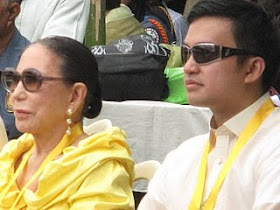 Governor Carmencita Reyes and Congressman Allan Jay Velasco during the Battle of Paye Anniversary Celebration,2010
Governor Carmencita Reyes and Congressman Allan Jay Velasco during the Battle of Paye Anniversary Celebration,2010I have a feeling you have not heard of this event in The Philippine-American History. Unless you you are a history enthusiast, I am pretty sure you do not know the details and significance of this battle in Philippine-American history. I heard of this battle when I read that a monument in Torrijos, Marinduque has been constructed to honor the Filipino and American soldiers that died in that Battle. The monument was constructed on a top of a hill with a beautiful view of the Eastern Marinduque Sea. It is now one of the historical tourist attraction in Marinduque.

Panoramic View of the Eastern Marinduque Sea from the Pulang Lupa Monument in Torrijos
My wife had been planning to see this place, but it required a long walk uphill, so we would not be able to make it. Here's a short description of the battle from Wikipedia for your reading pleasure.
"The Battle of Pulang Lupa was an engagement fought on September 13, 1900, during the Philippine-American War between the forces of Colonel Maximo Abad and Devereux Shields, in which Abad's men defeated the American force.
On September 11, Captain Devereux Shields led a detachment of 54 29th U.S. Volunteer Infantrymen into the mountains of Torrijos to combat the elusive Abad and his guerillas. They experienced little success, except for the dispersing of 20 guerillas, in which no casualties were inflicted on either side.
Abad had excellent intelligence and was informed of Shields' movements by the local guerillas ahead of time. In response, he assembled his entire force of 250 regular Filipino soldiers and around 1,000-2,000 bolomen. The regular Philippine soldiers were well organized and reasonably well armed with bolos, pistols, and Spanish Mausers, despite the fact that most were poor shots. The bolomen, armed only with machetes or bolos, served mainly to bolster Abad's forces. Dressed as friendly farmers or civilians in the day time, they took part in guerilla activities at night. Ambushing small detachments of American soldiers, sabotage, and most importantly, supplying Abad with intelligence on American positions and movements. They had little military value however, considering they had no firearms.
 American Soldiers of the 29th Infantry landing in Laylay, Marinduque, April 25, 1900
American Soldiers of the 29th Infantry landing in Laylay, Marinduque, April 25, 1900On September 13, Abad positioned his men along a steep ridge overlooking the trail which Shields would soon cross. Both Shields and his men had little combat experience and easily fell into the trap. Abad and his 250 soldiers opened fire on the column, which led to a fire-fight that lasted for several hours. Meanwhile, as the Americans and Philippine riflemen exchanged fire, the large force of Filipino bolomen began maneuvering to surround the Americans.
Shields, seeing that he was almost completely surrounded, ordered a withdrawal, which soon turned into a full blown retreat, as Abad's much larger force poured over the ridge after Shields and his men. The Filipino soldiers harassed Shields for nearly four miles (6 km) before cornering them in a small rice field; their escape to Santa Cruz was cut off by the large force of Filipino bolomen. Abad's men again opened fire, forcing the Americans to take cover behind some paddy dikes.
Shields, recognizing the futility of the situation, raised the white flag in order to surrender. Abad's men disregarded it and fell upon the totally encircled Americans firing and hacking away with bolo knives. In the fight, Shields fell severely wounded, shot through the shoulder and neck. Men of the 29th volunteer infantry wading ashore on Marinduque April 25 1900
Abad, observing that the Americans were trying to surrender, regained control of his men before any more surrendering Americans were slaughtered, and the survivors were led away as prisoners.
After months of hiding, Abad in only a few hours eliminated nearly one third of the American garrison on Marinduque.
The Americans lost 4 killed and 50 captured, 6 of which wounded including Shields. A large selection of American firearms were also taken by the guerillas. The Filipino losses are unknown, although Shields claimed to have inflicted 30 casualties on the Filipinos, this number was never verified.
Aftermath
Shields' defeat sent shock waves through the American high command. Aside from being one of the worst defeats suffered by the Americans during the war, it was especially significant given its proximity to the upcoming election between President William McKinley and his anti-imperialist opponent William Jennings Bryan, the outcome of which many believed would determine the ultimate course of the war. Consequently, the defeat triggered a sharp response.
Although Abad and most of his command had eluded the American military, the civilian population was suffering for it. Being placed into concentration camps and routine interrogation led many of the guerillas to surrender, thus decreasing the manpower and materials of the resistance. These new tactics led to the surrender of Abad in April 1901".
 Mural of Pulang Lupa, Torrijos, Marinduque
Mural of Pulang Lupa, Torrijos, MarinduqueEvery year the province of Marinduque, celebrates the anniversary of this battle with a program at the site attended by the top provincial officials,along with the Governor and the Congress Representative of the lone district of Marinduque.
No comments:
Post a Comment